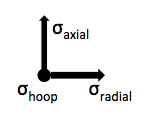| Include Page | ||||
|---|---|---|---|---|
|
| Include Page | ||||
|---|---|---|---|---|
|
Hoop, Axial and Radial Stresses in Thick-Walled Pressure Vessels
Created using ANYS 14.0
Problem Specification
Consider the following pressurized thick-walled hydraulic cylinder. The following figure shows a section through the mid-plane.
P = 10,000 lb, L = 100 in, a = 75 in, b = 3 in, h = 8 in
The material is structural steel with Young's modulus _E_= 2.9e7 psi and Poisson's ratio of 0.3. Using ANSYS Mechanical, find the finite-element solution for non-dimensionalized maximum deflection defined as: !2dbeam_eq1.png!
Compare the finite-element solution for plane stress and plane strain to Euler-Bernoulli beam theory. Discuss the comparison between the finite-element and beam theory results. Note that the non-dimensionalized maximum deflection is independent of the Young's modulus.
Stress directions in cylindrical coordinates:
σhoop is in the circumferential direction (out of the plane here)
a = inner radius = 1.5 in
b = outer radius = 2 in
Assume the cylinders are 18 inches long and the vessel is pressurized to 1000 psi. Here, we will be interested in finding the hoop, axial and radial stresses at the mid-length of the cylinders (@ 9 inches), to neglect the local effects of the end caps.
Compare the finite element results obtained from axisymmetric analysis to those calculated with the theoretical formulae for both thin-wall and thick-wall approximations.
Note: For this problem, the material choice will not affect the stresses; it will only affect the displacements and strains.
Learning Goals
The purpose of this tutorial is to showcase, in a relatively simple situation, where thin-wall pressure vessel theory is no longer as valid as it is in the limit of large radius-to-thickness ratios. The point is that inadequate theory should not be used for validation purposes in the limit that the physical assumptions on which the theory is based break down. In this problem, this happens gradually as the vessel walls become thicker. This tutorial is meant to highlight where it is relatively straightforward to apply axisymmetric FEA and resolve a solution correctly that disprove analytical treatment with simple formulae derived for thin-walled vessels.
 Sign-up for free online course on ANSYS simulations!
Sign-up for free online course on ANSYS simulations!
